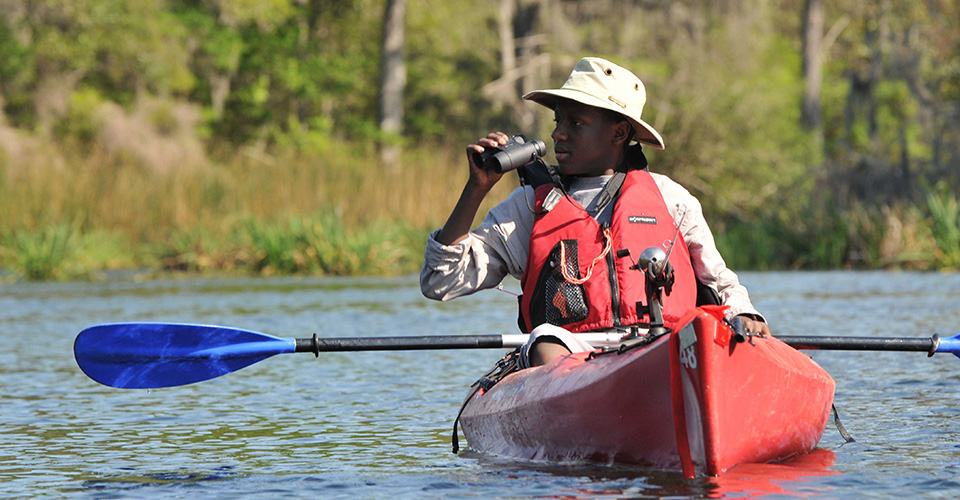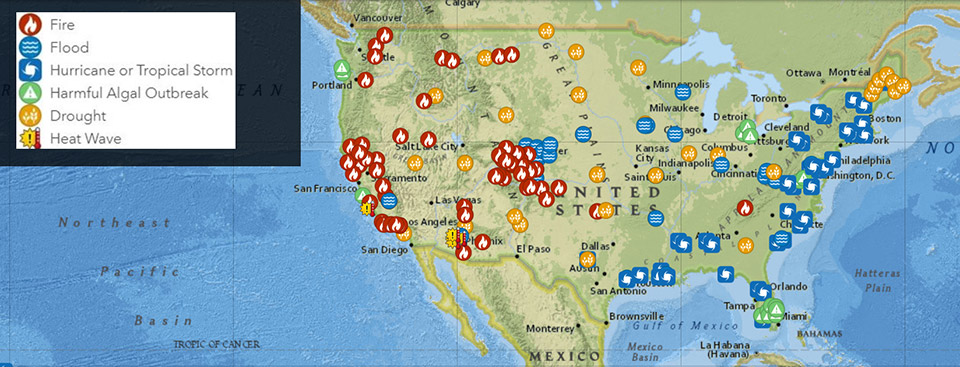
Human and wildlife communities around the globe are already feeling the effects of a changing climate. Some communities, however, are more vulnerable to these effects than others.
Climate vulnerability is determined by a community’s exposure and sensitivity to climate risks, and its capacity for coping with those risks. Many factors contribute to climate vulnerability, such as geographic location, how mobile individuals are, and demographic factors like age or race. Social factors such as access to health care, transportation, and parks; percentage of the population living in poverty; linguistic isolation; and more all play a role in driving climate vulnerability.
The National Wildlife Federation works to ensure that climate solutions benefit everyone equitably—including historically disenfranchised, frontline, rural and fossil fuel-dependent communities and workers, who often bear the brunt of the climate crisis. We work with a diverse array of partners to connect economic, health, and environmental solutions, helping make the case to decision-makers that ambitious climate action can build more just and sustainable communities for humans and wildlife alike. Explore some areas of this work below:
Natural disasters are becoming increasingly frequent and/or severe. Hurricanes, algal outbreaks, megafires, droughts, floods, and heatwaves are all among the natural disasters that are exacerbated by climate change. These events can destroy lives and livelihoods, causing billions in damage to homes and infrastructure and impacting the natural resources that our economy and health depend on. Our interactive Unnatural Disasters Story Map illustrates where natural disasters, many of which are exacerbated by climate change, have hit in recent years across the United States. Or, read our unnatural disaster blog series to learn more about how climate-exacerbated extreme heat, rising sea surface temperatures, and flooding affect communities and wildlife.

The National Wildlife Federation’s Interactive Unnatural Disasters Story Map
The impacts of these climate-fueled disasters do not affect all people equally. Understanding these disparities is the first step to ensuring that mitigation, response, and recovery is distributed equitably. For example: During a hurricane, a household without access to a car may have a harder time preparing or evacuating. People with greater income and savings may find it easier to bounce back after a storm.
Smarter policy is needed to ensure that federal aid for disaster recovery, relief, and mitigation target investments where the need is greatest. Learn more in our mini-report Rebuilding Stronger: 12 Priority Policies to Better Protect Our Nation from Extreme Storms. Investing in natural climate solutions can help reduce emissions and mitigate climate risk, while providing job opportunities in rural and urban areas across the country. Click here to learn more about natural climate solutions.
Frontline communities are communities overburdened by environmental hazards; they are often defined by locally unwanted land uses (like landfills or power plants) that negatively impact the health of community members and the health of the environment. Climate change compounds the burdens frontline communities face—and can make these communities increasingly climate-vulnerable.

Understanding which communities are the most at-risk of disproportionate environmental and climate effects is an important first step to crafting smart policy that aims to lessen inequity. Environmental justice screening and mapping tools like EPA EJSCREEN and MD EJSCREEN can illustrate the cumulative burdens of communities, support community voices by providing data to back up experiences, and support policy to ensure investments are targeted where the need is greatest. Our white paper, Environmental Justice Mapping Tools: Their Use and Potential in Policy Making to Address Climate Change, focuses on how online mapping tools can be a powerful ally in the fight for environmental and climate justice.

The Federation has also worked in collaboration with national and local partners to hold round table conversations with frontline community leaders, elected officials, and other key experts and environmental justice stakeholders. These discussions are crucial to understand the underlying issues that low-income communities and communities of color face, and how COVID-19 has made issues more severe. Learn more in our COVID-19 Environmental Justice Roundtable Series Summary of Findings and by viewing The State of the Environment in Black and Brown America: A National Townhall on Environmental Justice and Frontline Communities.
Coal-dependent communities across the country have been hit hard in recent years due to the transition away from coal-based energy. Other fossil fuels and renewable energy sources have become less expensive over time, allowing a shift to less-polluting energy. Plus, many states have instituted their own renewable energy requirements, increasing demand for clean sources of electricity. These combined factors have weakened demand for coal, and as a result, jobs in coal mining and coal-burning power plants are disappearing.
In these communities, economic vulnerability increasingly collides with climate vulnerability and heightens the need to move toward solutions that are good for families and local economies, as well as the climate. Investing in clean energy, mine land reclamation, and restoration can help diversify the economies of coal-dependent communities and bring community revitalization. Clean energy investments can help to stimulate economic growth and reduce carbon emissions to abate the climate crisis. In fact, some investments can specifically prioritize coal-based communities, maximizing pollution reductions in carbon-intensive areas, and helping ease the transition to a clean energy future. Restoring natural lands and waters and reclaiming old mined lands can help create jobs, improve local water and air quality, and create recreation opportunities that improve quality of life and attract tourism.

The National Wildlife Federation works with partners to help develop policy solutions that can benefit coal communities, including the Reimagine Appalachia coalition and the Just Transition Fund. Check out the Reimagine Appalachia Blueprint, the Just Transition Fund’s National Economic Transition Platform. In collaboration with the Partnership for Responsible Growth, we have also created a Coal Community Sourcebook with information about, ideas from, and contacts for local voices in Kentucky, West Virginia, and Wyoming that should be heard during policy discussions about how to revitalize and promote the economies of coal communities.
Photo credits: FWC photo by Tim Donovan (kayaker), National Wildlife Federation/ESRI (map), peggydavis66 (coal power plant), Bob Wick/BLM (adult and child on trail), Wayne National Forest/U.S. Forest Service (solar panels)
Take the Clean Earth Challenge and help make the planet a happier, healthier place.
Learn MoreA groundbreaking bipartisan bill aims to address the looming wildlife crisis before it's too late, while creating sorely needed jobs.
Read MoreMore than one-third of U.S. fish and wildlife species are at risk of extinction in the coming decades. We're on the ground in seven regions across the country, collaborating with 52 state and territory affiliates to reverse the crisis and ensure wildlife thrive.
